Sunday, 20 August, Greenville, SC: Wyeth and McKoy
Written 17 October 2017
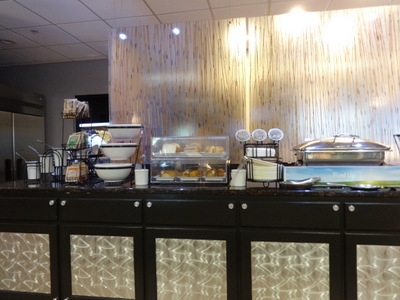
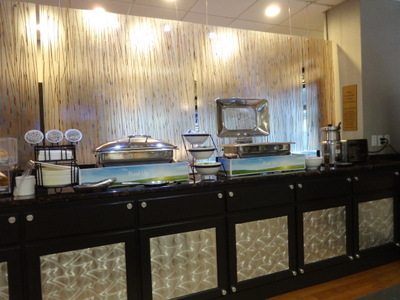 Breakfast at the Comfort Inn was not up to Viking's (or even home) standards. Slice Wonderbread, white and whole wheat; bagels large and small (I'll admit, small bagels were a nice touch); two kinds of muffins (no chocolate chip). Cold cereals. Some instant hot cereals, with raisins and things to add to them. Chafing dishes of scrambled eggs, flacid brown-and-serve sausages, and biscuits. Cold hardboiled eggs. Double boiler full of quite good sausage gravy. The two waffle irons, which might have been a redeeming feature, turned out to stick so badly that every waffle had to be chipped out of them with a fork, in small pieces.
Breakfast at the Comfort Inn was not up to Viking's (or even home) standards. Slice Wonderbread, white and whole wheat; bagels large and small (I'll admit, small bagels were a nice touch); two kinds of muffins (no chocolate chip). Cold cereals. Some instant hot cereals, with raisins and things to add to them. Chafing dishes of scrambled eggs, flacid brown-and-serve sausages, and biscuits. Cold hardboiled eggs. Double boiler full of quite good sausage gravy. The two waffle irons, which might have been a redeeming feature, turned out to stick so badly that every waffle had to be chipped out of them with a fork, in small pieces.
The scrambled eggs and sausages weren't very good but were vastly improved by a thick coating of sausage gravy. The biscuits, on which the gravy would normally have been put, turned out to be petrified.
In the course of the morning, we got together with the Sinnetts and their number-one son Henry and drove over to the house of Ev's brother Jay and his wife Pam, where we chatted while we awaited the arrival of Dale and Bert Shore, neighbors of the Sinnetts in Rockville, who had flown down to join the party. Once the whole group was assembled, we went out for a walk around downtown Greenville and lunch at Groucho's Deli.
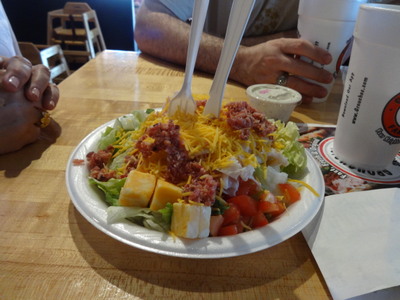
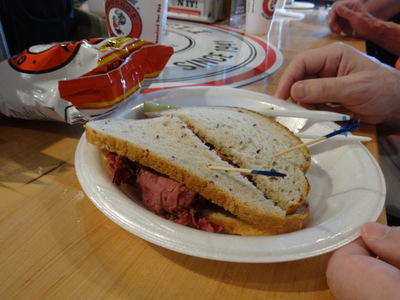 Service was glacial, but the food wasn't bad. I think Pam ordered this enormous salad.
Service was glacial, but the food wasn't bad. I think Pam ordered this enormous salad.
David had hot pastrami on rye (right).
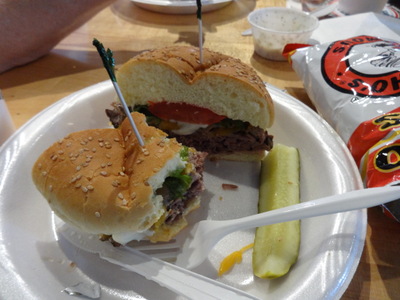
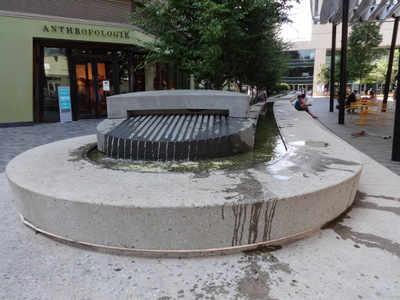 I tried the cheeseburger, which was medium rare as ordered. Pretty good.
I tried the cheeseburger, which was medium rare as ordered. Pretty good.
A few blocks away, we passed this nice little fountain, seen here end on. It stretched quite a ways off into the distance, and its long sinuous channel was popular with kids, who were climbing on it and floating leaf boats downstream.
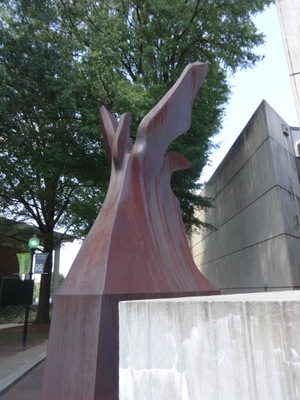
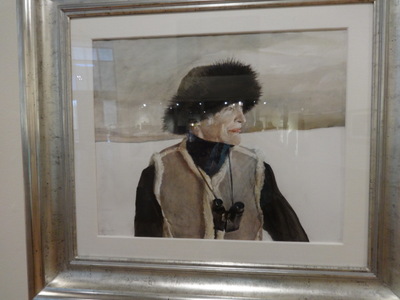 Our objective for the after noon was the city's art museum, which was feature all three generations of Wyeths. The Sinnetts are fans of Wyeth—the families lived near each other in Maine and were acquainted. Ev's parents own a few of their paintings. For some reason, the local art museum has quite a few Wyeths in its permanent collection and had gathered many others for this exhibition.
Our objective for the after noon was the city's art museum, which was feature all three generations of Wyeths. The Sinnetts are fans of Wyeth—the families lived near each other in Maine and were acquainted. Ev's parents own a few of their paintings. For some reason, the local art museum has quite a few Wyeths in its permanent collection and had gathered many others for this exhibition.
The piece at the left is not a Wyeth. It's "Mountain Flight 1976" by Richard Hunt and stands outside the museum's entrance.
The wonderful painting at the right is a Wyeth. It's "Betsy" by Andrew Wyeth, a portrait of the artist's wife, the former Betsy James.
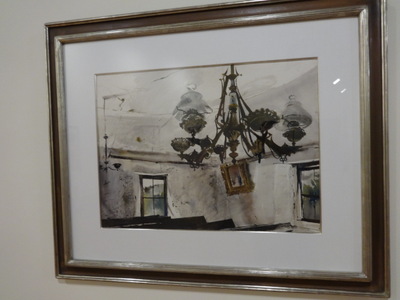
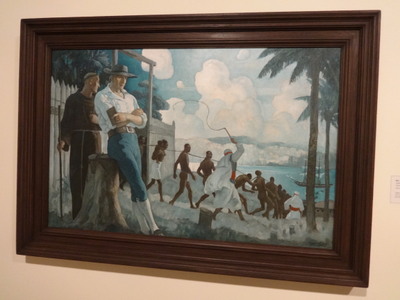 The painting at the left here is "Chandelier," also by Andrew Wyeth. (I confess, I like them all, but I'm especially partial to Andrew.)
The painting at the left here is "Chandelier," also by Andrew Wyeth. (I confess, I like them all, but I'm especially partial to Andrew.)
At the right is an illustration by N. C. Wyeth for Anthony Adverse. We agreed that it reminded us all of the depression-era paintings and mosaics that decorated the post offices and other public buildings of our youth.
This exhibition was especially good at making clear not only features of individual paintings that I would not have spotted otherwise but also explaining the relationships of the various members of the Wyeth family, which I had never had straight in my head.
Written 23 October 2017
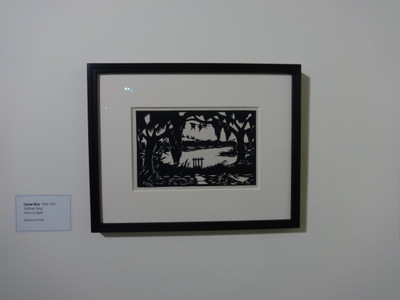
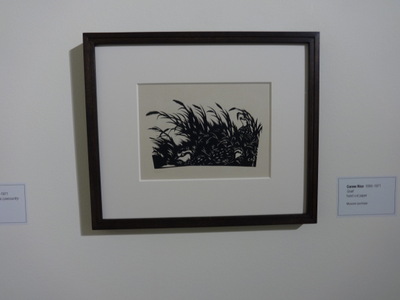 Several other, non-Wyeth exhibitions were also on display. At the left and right here are paper cuts by Carew Rice (1899–1971). Each one is hand-cut from black paper.
Several other, non-Wyeth exhibitions were also on display. At the left and right here are paper cuts by Carew Rice (1899–1971). Each one is hand-cut from black paper.
At the left is "Wildfowl Flying," and at the right "Quail." They're beautiful, but they are far smaller and far less coplex and detailed than the work of Tallahassee's own Lucrezia Bieler-Beerli. Check out the gallery some time at http://bieler-beerli.com/main/. Some of her pieces are three feet across. I think my favorite is the mandela with the alligator in the center surrounded by fishes and herons, though the one with the rattlesnake, rodents, and cacti is a close second.
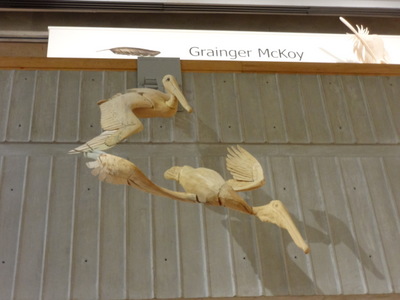
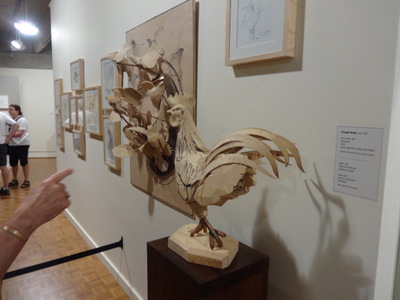 The exhibition that blew me away, though was the cast and carved birds by Grainger McKoy (1947–). These two photos are life-size preliminary studies for flying pelicans and a cock. A few of the pieces were cast in bronze, like an American Woodcock taking flight, but most are entirely wooden, carved from basswood (the only American congener of the European linden).
The exhibition that blew me away, though was the cast and carved birds by Grainger McKoy (1947–). These two photos are life-size preliminary studies for flying pelicans and a cock. A few of the pieces were cast in bronze, like an American Woodcock taking flight, but most are entirely wooden, carved from basswood (the only American congener of the European linden).
They are incredibly lifelike and detailed because they are not carved from single blocks of wood. He starts with an armature to represent the body, then carves and paints every feather individually, reassembling the entire bird periodically to double-check before disassembling it again to make adjustments.
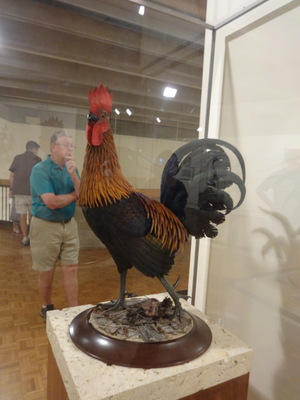
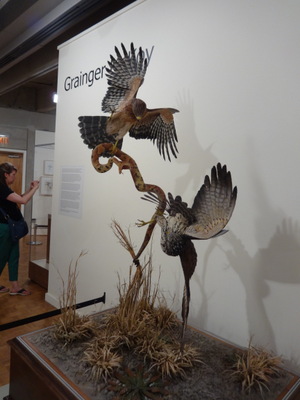 Here, at the left, is the finished cock, which is simply breathtaking! It's made of tupelo, basswood, metal, and oil paint.
Here, at the left, is the finished cock, which is simply breathtaking! It's made of tupelo, basswood, metal, and oil paint.
At the right is the largest and perhaps most impressive piece—two red-shouldered hawks battling a copperhead (basswood, metal, and oil paint). This was the only piece I had questions about—why were these hawks wresting with this snake? Red-shouldered hawks nest half-way up large trees, and copperheads seldom if ever climb more than a foot or two, and then they're looking for cicadas. The hawks eat mostly small mammals; sometimes they'll eat small lizards and snakes, but they don't hunt in pairs, and I couldn't see them tackling a specimen that size. On his website, though, the artists claims to have seen the incident. The adult was trying to eat the snake when a juvenile showed up and tried to steal a piece.
Finally, I can't imagine a pit viper (as opposed to a constrictor) coiling its tail around a tuft of broomstraw like that (but notice that the entire sculpture is supported by what must be a metal armature coming up through the straw and the snake (I peered closely but couldn't spot it) and maybe by the lower hawk's wingtip, which just touches the grass below. It is nowhere attached to the wall behind.
Imagine my anguished cry when, later, as we were leaving the museum, I found a notice by the front door saying that the artist had been there, less than two hours before, answering questions, while we were downstairs looking at the Wyeths!
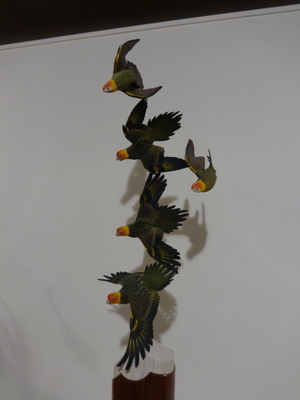
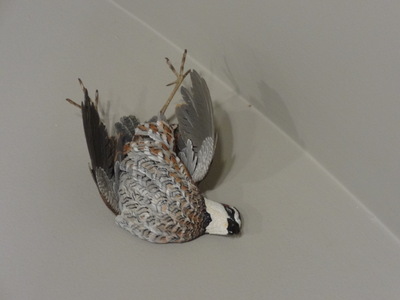 At the left here is a flight of five Carolina parakeets (extinct, sadly, since 1904). They are supported only where the lowest one's wing touches the white top of the pedestal. Neither the hawks nor the parakeets were behind glass, so you could look as closely as you liked, but the realism held up at even the closest range. This piece was on loan from the Audubon Society.
At the left here is a flight of five Carolina parakeets (extinct, sadly, since 1904). They are supported only where the lowest one's wing touches the white top of the pedestal. Neither the hawks nor the parakeets were behind glass, so you could look as closely as you liked, but the realism held up at even the closest range. This piece was on loan from the Audubon Society.
Of all the pieces in the exhibition, though, the one I most coveted was this exquisite little life-size dead quail. I've seen and handled many dead quail, and they are a favorite of 19th-century still-life painters; this one, though it's made of bronze and oil paint, is so real that I was sure that, if I picked it up, I would feel its limp weight and the warm, fluffy feel of its breast feathers and smell the characteristic odor of its plumage. I would love to have that bird, but since even the artists preliminary sketches and rough studies are priced way out of my range, it's pretty much out of the question.
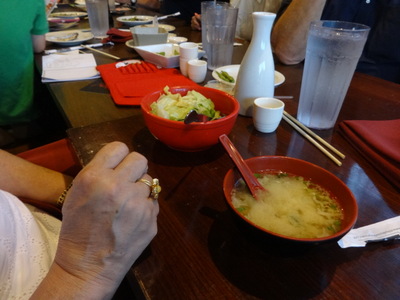
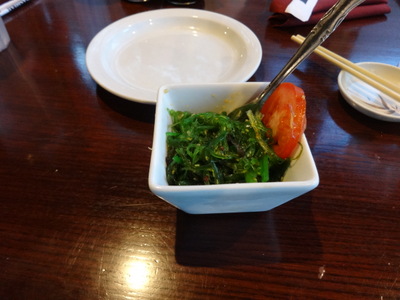 When the museum threw us out at closing time, we repaired to a local Japanese restaurant, where Jay had made reservations weeks before, in anticipation of the eclipse-related crowds coming to town. (Jay did a terrific job of planning ahead, so we had no trouble with the crowds. The one I felt sorry for was the lady I met in our hotel elevator whose family had planned a wedding for this weekend before the eclipse was widely advertised—hope they had all their reservations in place, too!)
When the museum threw us out at closing time, we repaired to a local Japanese restaurant, where Jay had made reservations weeks before, in anticipation of the eclipse-related crowds coming to town. (Jay did a terrific job of planning ahead, so we had no trouble with the crowds. The one I felt sorry for was the lady I met in our hotel elevator whose family had planned a wedding for this weekend before the eclipse was widely advertised—hope they had all their reservations in place, too!)
Most of us started with miso soup (left), and I had a seaweed salad, a particularly good rendition.
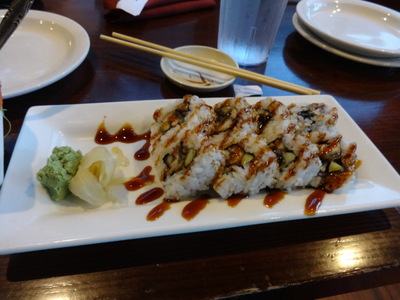
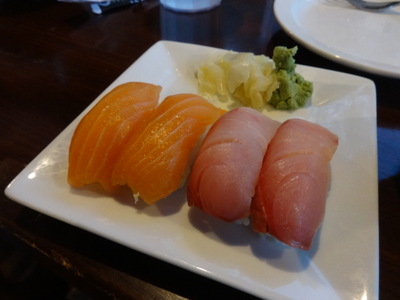 Here's my assortment of sushi, left, right, and below: eel roll, salmon and yellowtail nigiri, and a spicy shrimp roll.
Here's my assortment of sushi, left, right, and below: eel roll, salmon and yellowtail nigiri, and a spicy shrimp roll.
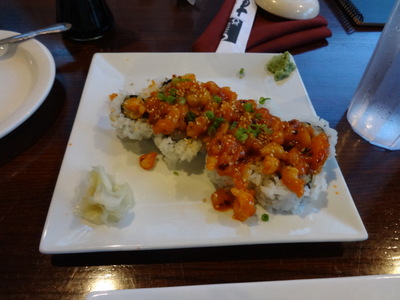
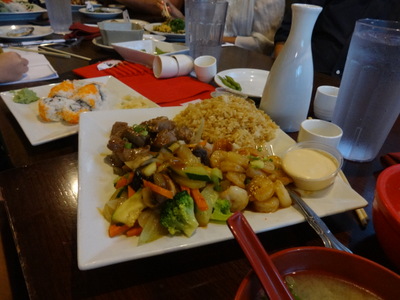 At the right here is, I think, Rachel's plate. She's allergic to fish, so she often skips the sushi and has something from the kitchen, here shrimp, beef, fried rice, and sauteed vegetables.
At the right here is, I think, Rachel's plate. She's allergic to fish, so she often skips the sushi and has something from the kitchen, here shrimp, beef, fried rice, and sauteed vegetables.
Previous entry
List of Entries
Next entry

 Breakfast at the Comfort Inn was not up to Viking's (or even home) standards. Slice Wonderbread, white and whole wheat; bagels large and small (I'll admit, small bagels were a nice touch); two kinds of muffins (no chocolate chip). Cold cereals. Some instant hot cereals, with raisins and things to add to them. Chafing dishes of scrambled eggs, flacid brown-and-serve sausages, and biscuits. Cold hardboiled eggs. Double boiler full of quite good sausage gravy. The two waffle irons, which might have been a redeeming feature, turned out to stick so badly that every waffle had to be chipped out of them with a fork, in small pieces.
Breakfast at the Comfort Inn was not up to Viking's (or even home) standards. Slice Wonderbread, white and whole wheat; bagels large and small (I'll admit, small bagels were a nice touch); two kinds of muffins (no chocolate chip). Cold cereals. Some instant hot cereals, with raisins and things to add to them. Chafing dishes of scrambled eggs, flacid brown-and-serve sausages, and biscuits. Cold hardboiled eggs. Double boiler full of quite good sausage gravy. The two waffle irons, which might have been a redeeming feature, turned out to stick so badly that every waffle had to be chipped out of them with a fork, in small pieces. 
 Service was glacial, but the food wasn't bad. I think Pam ordered this enormous salad.
Service was glacial, but the food wasn't bad. I think Pam ordered this enormous salad. 
 I tried the cheeseburger, which was medium rare as ordered. Pretty good.
I tried the cheeseburger, which was medium rare as ordered. Pretty good.
 Our objective for the after noon was the city's art museum, which was feature all three generations of Wyeths. The Sinnetts are fans of Wyeth—the families lived near each other in Maine and were acquainted. Ev's parents own a few of their paintings. For some reason, the local art museum has quite a few Wyeths in its permanent collection and had gathered many others for this exhibition.
Our objective for the after noon was the city's art museum, which was feature all three generations of Wyeths. The Sinnetts are fans of Wyeth—the families lived near each other in Maine and were acquainted. Ev's parents own a few of their paintings. For some reason, the local art museum has quite a few Wyeths in its permanent collection and had gathered many others for this exhibition.
 The painting at the left here is "Chandelier," also by Andrew Wyeth. (I confess, I like them all, but I'm especially partial to Andrew.)
The painting at the left here is "Chandelier," also by Andrew Wyeth. (I confess, I like them all, but I'm especially partial to Andrew.) 
 Several other, non-Wyeth exhibitions were also on display. At the left and right here are paper cuts by Carew Rice (1899–1971). Each one is hand-cut from black paper.
Several other, non-Wyeth exhibitions were also on display. At the left and right here are paper cuts by Carew Rice (1899–1971). Each one is hand-cut from black paper.
 The exhibition that blew me away, though was the cast and carved birds by Grainger McKoy (1947–). These two photos are life-size preliminary studies for flying pelicans and a cock. A few of the pieces were cast in bronze, like an American Woodcock taking flight, but most are entirely wooden, carved from basswood (the only American congener of the European linden).
The exhibition that blew me away, though was the cast and carved birds by Grainger McKoy (1947–). These two photos are life-size preliminary studies for flying pelicans and a cock. A few of the pieces were cast in bronze, like an American Woodcock taking flight, but most are entirely wooden, carved from basswood (the only American congener of the European linden). 
 Here, at the left, is the finished cock, which is simply breathtaking! It's made of tupelo, basswood, metal, and oil paint.
Here, at the left, is the finished cock, which is simply breathtaking! It's made of tupelo, basswood, metal, and oil paint.
 At the left here is a flight of five Carolina parakeets (extinct, sadly, since 1904). They are supported only where the lowest one's wing touches the white top of the pedestal. Neither the hawks nor the parakeets were behind glass, so you could look as closely as you liked, but the realism held up at even the closest range. This piece was on loan from the Audubon Society.
At the left here is a flight of five Carolina parakeets (extinct, sadly, since 1904). They are supported only where the lowest one's wing touches the white top of the pedestal. Neither the hawks nor the parakeets were behind glass, so you could look as closely as you liked, but the realism held up at even the closest range. This piece was on loan from the Audubon Society.
 When the museum threw us out at closing time, we repaired to a local Japanese restaurant, where Jay had made reservations weeks before, in anticipation of the eclipse-related crowds coming to town. (Jay did a terrific job of planning ahead, so we had no trouble with the crowds. The one I felt sorry for was the lady I met in our hotel elevator whose family had planned a wedding for this weekend before the eclipse was widely advertised—hope they had all their reservations in place, too!)
When the museum threw us out at closing time, we repaired to a local Japanese restaurant, where Jay had made reservations weeks before, in anticipation of the eclipse-related crowds coming to town. (Jay did a terrific job of planning ahead, so we had no trouble with the crowds. The one I felt sorry for was the lady I met in our hotel elevator whose family had planned a wedding for this weekend before the eclipse was widely advertised—hope they had all their reservations in place, too!)
 Here's my assortment of sushi, left, right, and below: eel roll, salmon and yellowtail nigiri, and a spicy shrimp roll.
Here's my assortment of sushi, left, right, and below: eel roll, salmon and yellowtail nigiri, and a spicy shrimp roll.
 At the right here is, I think, Rachel's plate. She's allergic to fish, so she often skips the sushi and has something from the kitchen, here shrimp, beef, fried rice, and sauteed vegetables.
At the right here is, I think, Rachel's plate. She's allergic to fish, so she often skips the sushi and has something from the kitchen, here shrimp, beef, fried rice, and sauteed vegetables.